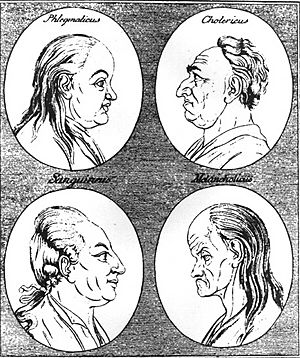Temperament facts for kids
Temperament is a cool word in psychology that helps us understand how different people behave. It's like your natural style of reacting to the world. Think about whether you're a quiet person or someone who loves to be around lots of people. These are examples of temperament. Many experts believe that your temperament is something you are born with. It's not something you learn from others. It also seems to be separate from your mood. So, you can be in a bad mood, but your basic temperament stays the same.
What is Temperament?
Temperament describes your natural way of acting and feeling. It's like your basic personality blueprint. For example, some people are naturally more energetic. Others are more calm. Some might be shy, while others are outgoing. These are all parts of your temperament.
Scientists who study the mind, called psychologists, often think that temperament is something we are born with. It's not something you pick up from your parents or friends. It's part of your genes. This means your temperament is usually set from a young age. It stays pretty much the same throughout your life.
Ancient Ideas About Temperament
Long ago, a famous Greek doctor named Galen of Pergamon lived around 200 AD. He was one of the first people to talk about different types of temperament. He called them "humors." Galen believed that our bodies had four main liquids, or humors. The balance of these liquids affected our personality.
Galen identified four main temperaments:
- Phlegmatic: These people were thought to be calm, quiet, and peaceful. They might be a bit slow to react.
- Choleric: People with this temperament were seen as energetic, passionate, and sometimes quick to get angry.
- Sanguinic: This group was believed to be cheerful, optimistic, and very social. They loved being around others.
- Melancholic: These individuals were often described as thoughtful, artistic, and sometimes a bit sad or serious.
Galen linked these temperaments to the four classical elements: fire, water, earth, and air. While we know today that personality is more complex, Galen's ideas were important for understanding human behavior for many centuries.
Temperament Today
Today, psychologists still study temperament. They look at how it affects our lives. They agree that some parts of our personality are innate, meaning we are born with them. For example, how easily you get excited or how you handle new situations might be part of your temperament.
Modern research uses different ways to describe temperament. They might talk about how active someone is, how easily they get upset, or how well they can focus. Understanding your own temperament can help you know yourself better. It can also help you understand why others act the way they do.
See also
 In Spanish: Temperamento para niños
In Spanish: Temperamento para niños


